In the recent weeks and months I have found myself asking the question over and over again, “Why would you shoot an unarmed or restrained person when they were not a threat?” and the answer has bounced back and forth between hatred and fear. Or perhaps more accurately the hatred that is brought on by fear. It seems that the police who are unnecessarily killing Black men, women, and children are doing so because they are afraid. Afraid of some mystical power they seem to believe we have all been imbued with. We have become the embodiment of the trope of the Magical Negro.
The trope of the Magical Negro (MN) is one in which the Black character serves in a supporting role and comes to the aid of a white protagonist. In this case the MN’s power comes from some special kind of insight or other mystical power. While this trope has been arduous in its cinematic depictions, it becomes downright dangerous as it begins to evolve and permeate other media and real world consciousnesses.
Thinking about the evolution of the MN means not only looking at its movement and shifts between the media and the real world, but also the shift that occurs in the trope as it morphs from one being,who is both magical and indestructible, in service to the white protagonist to (more importantly) having agency (of unknown origins and intentions). It is as this indestructible force that the Magical Negro becomes the Ultimate Threat.
In its more traditional manifestation we see the MN in well known film’s like The Green Mile where Michael Clark Duncan’s character, John Coffey, uses his mystical powers to save the prison’s head guard and his eventual executioner (Tom Hanks) by allowing him to redeem himself for participating in a system that unfairly oppresses marginalized people, and to save the warden’s wife as well by absorbing, to his own detriment, the cancer that is killing her. He makes the ultimate sacrifice. Ironically, John Coffey is able to save most everyone else in the film, but in the end welcomes death as a means of saving himself from the cruelty of the world around him.
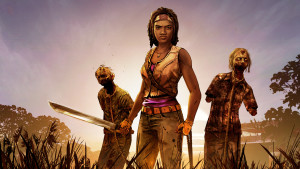 We also see Laurence Fishburne as the MN in The Matrix films. As Morpheus, Fishburne is the magical conduit that guides Keanu Reeves’ character, Neo, on his rightful journey to becoming The One. Morpheus has no real power of his own; his mysticism is all in service to Neo. We see this again and again in numerous films and even in comics. Comic characters like The Walking Dead‘s Michonne earn their MN status not by any actual mystical powers, but rather the perception of that mysticism. In the case of Michonne this perception is fed by the fact that she travels alone in harrowing environs and keeps zombies as pets. She is legend. She is also both the bridge between different media as we see her both in print and in her own game in Telltale’s 2016 game, The Walking Dead: Michonne.
We also see Laurence Fishburne as the MN in The Matrix films. As Morpheus, Fishburne is the magical conduit that guides Keanu Reeves’ character, Neo, on his rightful journey to becoming The One. Morpheus has no real power of his own; his mysticism is all in service to Neo. We see this again and again in numerous films and even in comics. Comic characters like The Walking Dead‘s Michonne earn their MN status not by any actual mystical powers, but rather the perception of that mysticism. In the case of Michonne this perception is fed by the fact that she travels alone in harrowing environs and keeps zombies as pets. She is legend. She is also both the bridge between different media as we see her both in print and in her own game in Telltale’s 2016 game, The Walking Dead: Michonne.
As we discover the MN in video games we see characters that are not necessarily in service to a white protagonist. In some cases they themselves are the protagonist, but what we do see are characters who are difficult or impossible to kill. And as in the case of Michonne, most of them are completely devoid of mystical power and instead get their MN status from the lore that surrounds them.
In The Walking Dead: Season One, the protagonist, Lee Everett, earns his label as MN not by any kind of magical power, but rather by the fact of sheer will he survives zombie attacks, zombie bites, the field amputation of a limb, and much more to get his juvenile charge to the place where she believes she will be able to find her parents. And he successfully does this before he succumbs to the zombie infection and finally makes the ultimate sacrifice.
While we see more cases of legendary status and self sacrifice in characters like Carl “C.J.” Johnson from Grand Theft Auto: San Andreas(2004), Aveline de Grandpre from Assassin’s Creed: Liberation (2012), and Nilin from Remember Me (2013). All of these characters have managed to disappoint in some way. They have been based on a stereotype or had some other kind of tragic flaw. And that is why I originally had such high hopes the upcoming game from 2K Games, Mafia III and its main protagonist, Lincoln Clay.
But as the release date comes closer and closer those hopes are waning. Lincoln Clay is being portrayed as the MN who lived (no pun intended). In the game’s E3 trailer, the Italian mob boss berates a hitman who participated in the killing of the rest of Clay’s Black mob family because he only shot him once in the head at point blank range.
And everyone knows that a true Magical Negro can not be killed by a single bullet. This early trailer has since been joined by an additional trailer that focuses on the voodoo and mysticism that is associated with life in New Orleans, including one that introduces us to Cassandra, the “Voodoo Queen”, who joins Clay in his quest for vengeance against the family that murder the Black mob and tried to murder him. Despite these dubious depictions, I believe that Mafia III still has some potential to critique race and racism in the 1960s South. We see glimpses of confederate flags and cross burnings and know that this possibility still exists, however slight.
 We have recently seen other games, like Eidos’ upcoming game Deus Ex: Mankind Divided, destroy any possibility of this kind of fruitful critique. The last game in the Deus Ex series had problems with racial representation of its own and the new installment has been on my (and many others’) radar for quite a while because of the fact that they began emphasizing the notion of “mechanical apartheid” last year to frame the oppression of augmented humans in the game, even after being criticized for the racial and cultural blindness inherent in the use of that terminology. At the time that they first posited the idea of mechanical apartheid, games critics like Vice Gaming’s Austin Walker called them to task on the historical insensitivity and rather than address it in this latest campaign they have seemingly decided to double down on it and released new game art this week co-opting the Black Lives Matter campaign.
We have recently seen other games, like Eidos’ upcoming game Deus Ex: Mankind Divided, destroy any possibility of this kind of fruitful critique. The last game in the Deus Ex series had problems with racial representation of its own and the new installment has been on my (and many others’) radar for quite a while because of the fact that they began emphasizing the notion of “mechanical apartheid” last year to frame the oppression of augmented humans in the game, even after being criticized for the racial and cultural blindness inherent in the use of that terminology. At the time that they first posited the idea of mechanical apartheid, games critics like Vice Gaming’s Austin Walker called them to task on the historical insensitivity and rather than address it in this latest campaign they have seemingly decided to double down on it and released new game art this week co-opting the Black Lives Matter campaign.
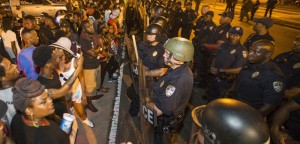 This new art work specifically depicts “augs” holding signs that read “Augs Lives Matters” as they face off against police in riot gear. A scene that we have seen depicted on numerous U.S. streets in recent months and years in response to the murders of Black men, women, and children by police officers in cities across the country. The level of racial and cultural insensitivity necessary to depict the fictional oppression of humans with cybernetic parts in a video game is unfathomable.
This new art work specifically depicts “augs” holding signs that read “Augs Lives Matters” as they face off against police in riot gear. A scene that we have seen depicted on numerous U.S. streets in recent months and years in response to the murders of Black men, women, and children by police officers in cities across the country. The level of racial and cultural insensitivity necessary to depict the fictional oppression of humans with cybernetic parts in a video game is unfathomable.
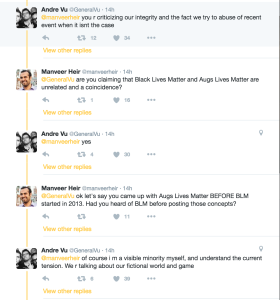 Bioware’s Manveer Heir, vocal proponent of diversity in video games and Mass Effect designer, went toe-to-toe with the game’s marketing director, Andre Vu, on social media about the inappropriateness of the campaign and it’s appropriation of the language and ethos of the Black Lives Matter movement. Inherent in Heir’s discussion and the general critique of the marketing campaign itself is the fact that, by using the slogan “Augs Lives Matters” Eidos’ marketing campaign is essentially reducing the BLM movement and the very deaths of the people unjustly killed by police to a joke, a buzz phrase, something unworthy of serious consideration and political action. Vu’s claims of cultural and political disconnectedness between his marketing campaign and the BLM movement is not only ridiculous, but downright fucking insulting. And this is the moment that the connection between the messages in and around video games’ “fictional worlds” and the “real world” becomes even more apparent.
Bioware’s Manveer Heir, vocal proponent of diversity in video games and Mass Effect designer, went toe-to-toe with the game’s marketing director, Andre Vu, on social media about the inappropriateness of the campaign and it’s appropriation of the language and ethos of the Black Lives Matter movement. Inherent in Heir’s discussion and the general critique of the marketing campaign itself is the fact that, by using the slogan “Augs Lives Matters” Eidos’ marketing campaign is essentially reducing the BLM movement and the very deaths of the people unjustly killed by police to a joke, a buzz phrase, something unworthy of serious consideration and political action. Vu’s claims of cultural and political disconnectedness between his marketing campaign and the BLM movement is not only ridiculous, but downright fucking insulting. And this is the moment that the connection between the messages in and around video games’ “fictional worlds” and the “real world” becomes even more apparent.
In his article “Cinethetic Racism: White Redemption and Black Stereotypes in “Magical Negro” Films,” when talking specifically about the use of the trope in film, Matthew W. Hughey argues that
Due to the racially segregated character of the United States, many within its borders
spend little time interacting with people of different racial or ethnic groups. This point is particularly true for whites. Eighty-six percent of suburban whites live in a community where the black population is less than 1 percent, and “According to the 2000 Census, whites are most likely to be segregated than any other group”. As a result, popular films about race and racism offer people, especially whites, narratives for experiences they may not have in real life. In fact, in the absence of lived experience, films are often understood as “authentic” reflections of “real life.”
If we are to place any stock at all in what Hughey has to say about the effect that continued segregation has on racial understanding and, by extension, the ability to empathize would be almost non-existent. It is the lack that we see made manifest in not only the latest Eidos “Augs Lives Matters” campaign, but in Andre Vu’s assertion that it is totally unrelated.
If we take a moment to look at what this phenomenon looks like played out not only through perspective, but systemically we can begin to see how the police officers(and the people in the American public who attempt to explain away their behavior) who are killing Black people have come to the conclusion that Black people are somehow mystical or inhuman.
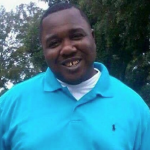
How they have come to the conclusion that Black people…that we…possess a superhuman strength that necessitates them firing multiple shots into our chests at point blank range while completely restrained in order to prevent us from magically freeing ourselves and retrieving a weapon. Because, like Lincoln Clay, we may just be indestructible beings who can’t be stopped by only one bullet.
RIP Alton Sterling 1979-2016

How they have come to the conclusion that we are somehow transformed into something super- or in- human by sheer determination. How we become “like a demon” in nature and visage when we are driven to a specific goal and how demons are slain swiftly and mercilessly, often to save innocent souls.
RIP Michael Brown 1996-2014

How they have come to the conclusion that, as children, we can magically transform a toy pistol into a real one as we play alone on the swings necessitating that we are shot within 2 seconds of their arrival on the scene without questioning or proper assessment of the situation.
RIP Tamir Rice 2002-2014

How they have come to the conclusion that we can metamorphose into some kind of magical killing machine who can simultaneously cradle a child, wield a shotgun, and film the SWAT team that has been dispatched to our home to serve a misdemeanor traffic warrant, making it necessary to open fire on us and our unarmed 5 year old child.
RIP Korryn Gaines 1992-2016
The list of the Black men, women, and children who have been killed by a system fueled by the notion that we are great and dangerous in our magical and murderous abilities is far too long to display here (or even begin to do justice to).
If we are going to address the systemic racism that has murdered or injured so many of us we must begin by critiquing the manner in which Black people in general are being portrayed as Magical Negroes who are capable of great and terrible things. Because in many ways the fear that drives these murderous systems and individuals is understandable in that they can only act and react based on how they would react if they had been treated in a similar manner for as long.

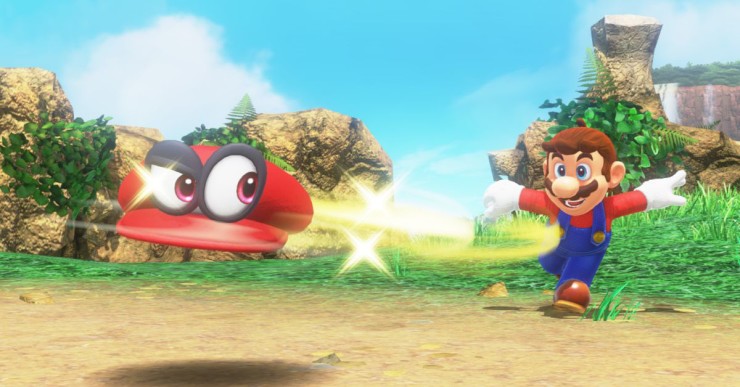
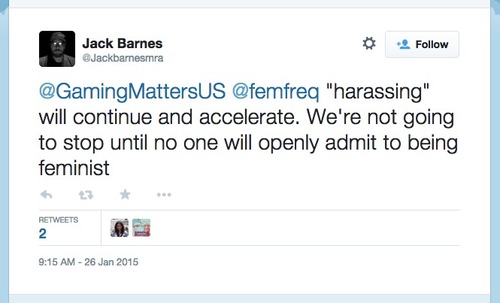

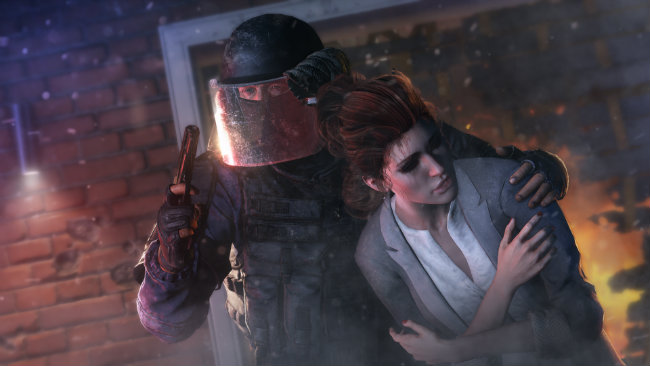
8 thoughts on “Beware the Magical Negro: On Tropes, Race, and Black Lives Matter”
Samantha, I see where you’re coming from, but you push it too far. Some of your MN claims are just heroes who happen to be black, which is A GREAT THING that you should be encouraging. Instead you come off as a girl who cries wolf^H^H^H^Hracism, and it makes your essay sound like “don’t put any black characters or references in games unless they meet my standards of approval”. I doubt that’s what you wanted to say.
For starters, MN is defined by its status as supporting character. Consequently, Michonne is not MN, she’s a starring badass action girl, totally separate tropes. Likewise, a black lead protagonist (e.g. Lee Everett) is not MN even if he dies at the end. Self-sacrifice by the hero is not the same as supporting sacrifice on behalf of the real hero.
I can see how “Augs Lives Matter” is questionable, but I also have to wonder, what do you think of the ST:OS episodes “Let That Be Your Last Battlefield” or “Patterns of Force”? What are appropriate boundaries for cultural appropriation in science fiction?
Lastly, Korryn Gaines really did hold her child, record video, AND (most importantly) aim & fire her shotgun at cops after a multi-hour negotiation. No matter what color your skin, doing that is likely to get you killed.
Nevertheless, your central thesis and other points remain valid.
I completely disagree that Michonne and Lee are MNs. Michonne is a well developed character with a rich backstory, and is certainly not just a mechanism to prop up a white character. Lee is the hero of the video game adaptation, and ultimately his main purpose is to take care of Clementine, a girl of mixed race.
Look at both TV Tropes and Wikipedia and you’ll see these two characters don’t fit.
First, let’s not pretend TV Tropes and Wikipedia are the end-all authorities on anything at all; both can be valuable sources, but a lot of richer, more in depth material exists beyond these sites. Second, I think a case can be made for both of these, and is done here; perhaps you don’t agree, and that’s fine, but as much as I love Michonne, I am not sure I could agree that she is a main character in the show, at least, though in the comic she’s been subjected to some wider exploration. She’s first a supporting character — literally! — for Andrea, then support for Carl, and often a foil for Rick; she’s one of the lenses through which we can explore Rick’s behavior. Apart from her emotional moment with Judith, her being alone again after the prison, and some other individual moments here and there, we haven’t gotten as much of her story. Now, this argument can be made in a similar fashion for a lot of the main cast, as an ensemble show, but she has at times very much fit in traditional interpretations of the magical Negro.
Lee may be a main character, but I think Sam’s read of him here is fascinating; what he does is in service to himself and his own arc, but ultimately that arc is always meant to end in service to Clementine, who may be biracial, but her race is never at the forefront of her character, as Lee’s is at times. From the beginning, and especially if we want to pull in other tropes, it seems clear that protecting Clementine will serve as Lee’s redemption, for while he may be a good guy at heart, he still made some very questionable choices, and in the hands of the player may make more. His journey may redeem him, but it also serves as the prop for Clementine’s growth from a child into a capable young survivor. Are we talking about textbook, no-gray-area interpretations of the trope? Nah, and I’m okay with that, too; it would make these properties less interesting, but I think the argument here is supported in terms of the evolution of the trope (something else referenced in the original).
Thanks to the folks who came by to tell me what the definition of a Magical Negro is, but you will notice that I did start the piece with a definition and I say specifically that I wanted to look at how I see the trope evolving so that the characters were no longer in service to white protagonists and were sometimes protagonists themselves. What I focus on in the media with the evolved trope is the notion of magic and mysticism.
Also, please note that I don’t see a problem with games as social commentary because I believe that they always already are to some extent. Where my issue lies is with the cultural blindness and trying to be edgy by grabbing on to a current issue. I think that these practices, specifically, diminish the import of the issue at hand. As I say in the post, I am hopeful that Mafia III can use it’s narrative to focus on the history of racism in the American South and thus give players a better chance to understand how racism is systemic (when tracing it through and comparing it to how we see racism made manifest in this moment).
And on Korryn Gaines, a big picture view is necessary. Big picture not only in terms of her specific case, but in the cases of numerous white people who have (several even since her murder) been in similar situations and been taken into custody unscathed, but that I am not willing to debate here.
Thanks for the thoughtful reply. The problem remains: it sounds like you’re saying ANY strong black character is automatically MN. Why are we not allowed to have action heroes who are black, alongside action heroes who are white, latin, asian, indigenous, etc? Action heroes are almost always magically tough, walking off wounds that would incapacitate any real person.
In video games, race is literally just “skin” deep, and players know that any character of any race, gender, size, etc, can be a brute (or not) if the game assigns the stats that way. For an easy counterexample, video games probably stereotype asians more than any other race, but it doesn’t cause people to fear being ki-punched in real life.
Of course we are allowed to have strong Black characters. We want strong characters of all races, creeds, and colors. But my point with this analysis (that extends past just games) one that takes into account the world outside of the game. Looking at the racial, social, and cultural history of the world in which the game exists. That is why this connection to magic and mysticism becomes even more important.
If I were looking at games as just games I could more aptly see your point, but I see games as more. As cultural artifacts. And your point about Asian people in the real world does not hold up for me, because in the real world the stereotypes about Asian people does not include violence and animalistic representation, but rather that all Asians are physically small, meek, subservient and intelligent and that is where the argument breaks down in this case. Also note that my focus on Black characters, critical race theory, and African American history/culture/representation does not negate the problems with other races in media and the real world, it is just not my area of study and there are other folks whose scholarship can and does do justice to that topic far better than mine ever could.
Okay, I think I get it a little better. I have one final question: what do you recommend? What should video game creators and players do differently, specifically regarding video games? Obviously all human beings need to treat each other better in general, both in person and online, but your essay is about racial issues in gaming.
What should Telltale have done with Michonne and Lee? Should the community have boycotted Walking Dead games to protest their portrayals? How might Eidos properly use discrimination against augs as a parable about real-world minorities?
I think it can boil down to better storytelling in games. Even in the case of Deus Ex, a well told story (sans the Augs Lives Matter because that’s just silly and reductive) could be used as cultural critique. Look at systems of oppression as they occur in the real world and use that as a foundation for a well told/played story in the game.
Do I think that the TT (or any games) should be generally boycotted because of their portrayals? No. I do, however, think that they are open to critique so that we can talk about how things might be made better. And in the case where a game just crosses a personal line for folks they can use their own judgement on whether or not to buy the game at all. As consumers we have a wee bit of economic power.